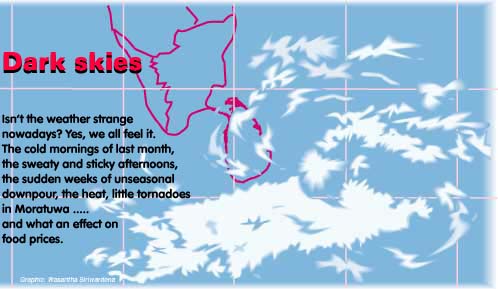It seems that La Nina is playing with the weather
now
Dark skies

By Tharuka Dissanaike
Weather gurus worldwide agree that the old systems are not running like
they used to. Fingers point at the culprits- El Nino and now his sister
La Nina. These extreme weather phenomena have affected this part of the
world too.
Last year when El Nino was at its destructive worst, Sri Lanka's weather
also went haywire. It has been months since El Nino died off but now, La
Nina is looking up, hence disturbed weather patterns will continue, weather
experts predict. Meanwhile the public bemoans the rising food prices. Everything
from the government, the traders, to the war and elections is blamed for
the escalating prices of basic food items. A few weeks ago, onions and
potatoes reached a record high, now rice is steeply climbing, chillies,
dhal and grains are expensive. Yet drastic food price escalations this
past year are chiefly the fault of La Nina.
Agricultural Department estimates show that around 20 percent of the
Maha season rice yield was spoilt due to bad weather. "Maha is the most
productive season for rice," Dr. S.S.B.D.G Jayawardena, Acting Director,
Department of Agriculture said.
Harvests of chillie, maize, green gram were also affected by the heavy
rains during January and February which are traditionally the harvest months.
"Unseasonal rains and the late North-East monsoon disrupted sowing and
nurseries as well as harvests. Since our farmers await rain to sow, rain
to nurture and dry weather to harvest, crops are easily destroyed by unplanned
rainfall or dry weather. This was exactly the situation last year when
the country's normal climatic patterns went haywire."
Last year started with little rain. Even areas which traditionally receive
some rainfall in January, February and March sweltered under a relentless
sun and suffered through a dry spell. The dry spell lasted until end April,
but not long enough to really affect the hydro systems (which had additional
capacity through thermal power anyway) or cause a water supply problem.
The dire warnings of a drought year did not see daylight though, since
it rained steadily since the monsoon in May. Some may remember 1998 as
one of the wettest years, since it seemed like the rainy spells would never
end.
But comparing average rainfall in different locations of the country
for the year, there is no such drastic deviation from the norm- the figure
computed on a 30-year average. But it is the entire pattern of seasons
that has changed. And it looks like this year too the weather gods will
ignore the traditions of monsoon and inter-monsoon seasons. In the first
four months of 1998, half the country received less than 25 percent of
the normal rainfall for that period. "It was in January 1998, when El Nino
was at its peak," Deputy Director of the Meteorological Department, P.M
Jayatilleka Banda said. "This is what caused the dry, rainless period in
early 1998.
"The inter-monsoon rains, which normally break out in April came late.
But the monsoon brought average or slightly above average rainfall. The
next inter-monsoon that breaks out in October and November came down with
a vengeance coupled with upper atmospheric disturbances."
But the North East monsoon was late in coming and when it did it poured.
So much so that certain areas in the Eastern Province- Trincomalee, Ampara
and Batticaloa even flooded. A village in Batticaloa recorded 1000 mm of
rainfall in ten days. Not only did it rain hard, but it also continued
to rain, right throughout January and February. The dry spell that has
now settled upon the country is short- lived, says Mr. Banda.
Pointing to satellite photographs of cloud formation over the Indian
Ocean, he said that the cloud cover which had developed over the ocean,
south and east of Sri Lanka will bring in rainy weather very soon.(Graphic)
The Meteorological Department is unable to predict accurate dates for monsoonal
and inter-monsoonal showers.
"What we can do is predict rainfall or bad weather two to three days
before its onset, by reading satellite images. But long term predictions
of monsoons are not possible as they depend on wind patterns. A few days
before the monsoon's break-out we can accurately predict the dates, he
said.
Dr. Jayawardena adds: "But in a country with a rain-fed agricultural
system, when the weather gods play up, the result is chaos. Ninety per
cent of our agriculture depends on rainfall." To overcome the trials of
bad weather, Dr. Jayawardena said that the Agricultural Department is trying
to popularise drip irrigation, which is used in most arid countries to
cultivate food crops. The cultivation is fed through minute tubes carrying
water and fertiliser directly to the root- there is no waste and very little
water is needed for maximum benefits.
More Plus * He had a way of selecting words
-
Kala Korner By Dee Cee

Plus Archive
Front Page| News/Comment|
Editorial/Opinion|
Business|
Sports
| Mirror Magazine
|









